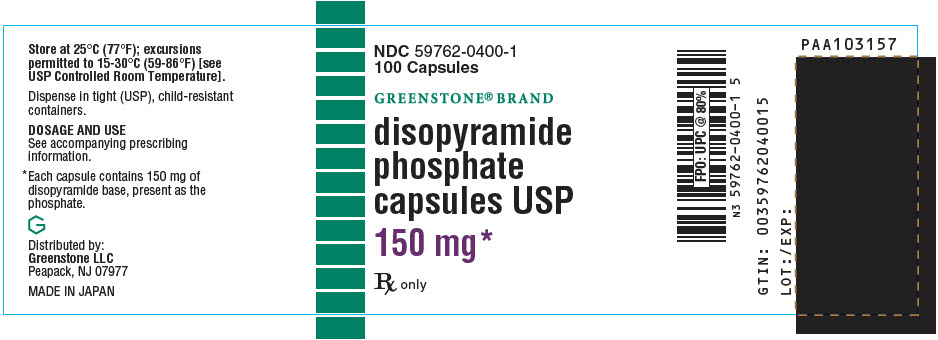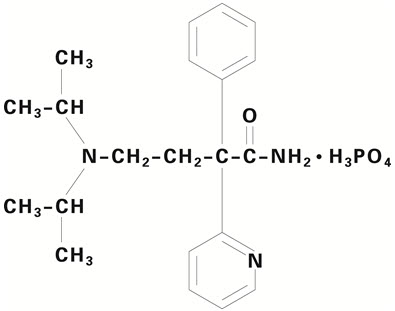Disopyramide Phosphate
Disopyramide phosphate capsules
31e79459-107f-4d69-a163-90014f1c4772
HUMAN PRESCRIPTION DRUG LABEL
Sep 12, 2023
Greenstone LLC
DUNS: 825560733
Mylan Pharmaceuticals Inc.
DUNS: 059295980
Products 2
Detailed information about drug products covered under this FDA approval, including NDC codes, dosage forms, ingredients, and administration routes.
disopyramide phosphate
Product Details
FDA regulatory identification and product classification information
FDA Identifiers
Product Classification
Product Specifications
INGREDIENTS (9)
disopyramide phosphate
Product Details
FDA regulatory identification and product classification information
FDA Identifiers
Product Classification
Product Specifications
INGREDIENTS (8)
Drug Labeling Information
PACKAGE LABEL.PRINCIPAL DISPLAY PANEL
PRINCIPAL DISPLAY PANEL - 150 mg Capsule Bottle Label
NDC 59762-0400-1
100 Capsules
GREENSTONE® BRAND
disopyramide
phosphate
capsules USP
150 mg*
Rx only

DESCRIPTION SECTION
DESCRIPTION
Disopyramide phosphate is an antiarrhythmic drug available for oral administration in immediate-release capsules containing 100 mg or 150 mg of disopyramide base, present as the phosphate. The base content of the phosphate salt is 77.6%. The structural formula of disopyramide phosphate is:

|
α-[2-(diisopropylamino) ethyl]-α-phenyl- 2-pyridineacetamide phosphate |
Disopyramide phosphate is freely soluble in water, and the free base (pKa 10.4) has an aqueous solubility of 1 mg/ml. The chloroform:water partition coefficient of the base is 3.1 at pH 7.2.
Disopyramide phosphate is a racemic mixture of d- and l- isomers. This drug is not chemically related to other antiarrhythmic drugs.
Inactive ingredients of disopyramide phosphate include corn starch, edible ink, FD&C Red No. 3, FD&C Yellow No. 6, gelatin, lactose, talc, and titanium dioxide; the 150-mg capsule also contains FD&C Blue No. 1.
HOW SUPPLIED SECTION
HOW SUPPLIED
Disopyramide phosphate is supplied in hard gelatin capsules containing either 100 mg or 150 mg of disopyramide base, present as the phosphate.
Disopyramide phosphate 100-mg capsules are white and orange, with markings SEARLE, 2752, NORPACE, and 100 MG.
|
NDC Number |
Size |
|---|---|
|
59762-0386-1 |
bottle of 100 |
Disopyramide phosphate 150-mg capsules are brown and orange, with markings SEARLE, 2762, NORPACE, and 150 MG.
|
NDC Number |
Size |
|---|---|
|
59762-0400-1 |
bottle of 100 |
Store at 25°C (77°F); excursions permitted to 15–30°C (59–86°F). [See USP Controlled Room Temperature.]
PRECAUTIONS SECTION
PRECAUTIONS
General
Atrial Tachyarrhythmias
Patients with atrial flutter or fibrillation should be digitalized prior to disopyramide phosphate administration to ensure that drug-induced enhancement of AV conduction does not result in an increase of ventricular rate beyond physiologically acceptable limits.
Conduction Abnormalities
Care should be taken when prescribing disopyramide phosphate for patients with sick sinus syndrome (bradycardia-tachycardia syndrome), Wolff-Parkinson-White syndrome (WPW), or bundle branch block. The effect of disopyramide phosphate in these conditions is uncertain at present.
Cardiomyopathy
Patients with myocarditis or other cardiomyopathy may develop significant hypotension in response to the usual dosage of disopyramide phosphate, probably due to cardiodepressant mechanisms. Therefore, a loading dose of disopyramide phosphate should not be given to such patients, and initial dosage and subsequent dosage adjustments should be made under close supervision (see Dosage and Administration).
Renal Impairment
More than 50% of disopyramide is excreted in the urine unchanged. Therefore disopyramide phosphate dosage should be reduced in patients with impaired renal function (see Dosage and Administration). The electrocardiogram should be carefully monitored for prolongation of PR interval, evidence of QRS widening, or other signs of overdosage (see Overdosage).
Hepatic Impairment
Hepatic impairment also causes an increase in the plasma half-life of disopyramide. Dosage should be reduced for patients with such impairment. The electrocardiogram should be carefully monitored for signs of overdosage (see Overdosage).
Patients with cardiac dysfunction have a higher potential for hepatic impairment; this should be considered when administering disopyramide phosphate.
Potassium Imbalance
Antiarrhythmic drugs may be ineffective in patients with hypokalemia, and their toxic effects may be enhanced in patients with hyperkalemia. Therefore, potassium abnormalities should be corrected before starting disopyramide phosphate therapy.
Drug Interactions
If phenytoin or other hepatic enzyme inducers are taken concurrently with disopyramide phosphate, lower plasma levels of disopyramide may occur. Monitoring of disopyramide plasma levels is recommended in such concurrent use to avoid ineffective therapy. Other antiarrhythmic drugs (e.g., quinidine, procainamide, lidocaine, propranolol) have occasionally been used concurrently with disopyramide phosphate. Excessive widening of the QRS complex and/or prolongation of the Q-T interval may occur in these situations (see Warnings). In healthy subjects, no significant drug-drug interaction was observed when disopyramide phosphate was coadministered with either propranolol or diazepam. Concomitant administration of disopyramide phosphate and quinidine resulted in slight increases in plasma disopyramide levels and slight decreases in plasma quinidine levels. Disopyramide phosphate does not increase serum digoxin levels.
Until data on possible interactions between verapamil and disopyramide phosphate are obtained, disopyramide should not be administered within 48 hours before or 24 hours after verapamil administration.
Although potent inhibitors of cytochrome P450 3A4 (e.g., ketoconazole) have not been studied clinically, in vitro studies have shown that erythromycin and oleandomycin inhibit the metabolism of disopyramide. Cases of life-threatening interactions have been reported for disopyramide when given with clarithromycin and erythromycin indicating that coadministration of disopyramide with inhibitors of cytochrome 3A4 could result in potentially fatal interaction.
Carcinogenesis, Mutagenesis, Impairment of Fertility
Eighteen months of disopyramide phosphate administration to rats, at oral doses up to 400 mg/kg/day (about 30 times the usual daily human dose of 600 mg/day, assuming a patient weight of at least 50 kg), revealed no evidence of carcinogenic potential. An evaluation of mutagenic potential by Ames test was negative. Disopyramide phosphate, at doses up to 250 mg/kg/day, did not adversely affect fertility of rats.
Pregnancy
Teratogenic Effects
Disopyramide phosphate was associated with decreased numbers of implantation sites and decreased growth and survival of pups when administered to pregnant rats at 250 mg/kg/day (20 or more times the usual daily human dose of 12 mg/kg, assuming a patient weight of at least 50 kg), a level at which weight gain and food consumption of dams were also reduced. Increased resorption rates were reported in rabbits at 60 mg/kg/day (5 or more times the usual daily human dose). Effects on implantation, pup growth, and survival were not evaluated in rabbits. There are no adequate and well-controlled studies in pregnant women. Disopyramide phosphate should be used during pregnancy only if the potential benefit justifies the potential risk to the fetus.
Nonteratogenic Effects
Disopyramide phosphate has been reported to stimulate contractions of the pregnant uterus. Disopyramide has been found in human fetal blood.
Labor and Delivery
It is not known whether the use of disopyramide phosphate during labor or delivery has immediate or delayed adverse effects on the fetus, or whether it prolongs the duration of labor or increases the need for forceps delivery or other obstetric intervention.
Nursing Mothers
Studies in rats have shown that the concentration of disopyramide and its metabolites is between one and three times greater in milk than it is in plasma. Following oral administration, disopyramide has been detected in human milk at a concentration not exceeding that in plasma. Because of the potential for serious adverse reactions in nursing infants from disopyramide phosphate, a decision should be made whether to discontinue nursing or to discontinue the drug, taking into account the importance of the drug to the mother.
Pediatric Use
Safety and effectiveness in pediatric patients have not been established (see Dosage and Administration).
Geriatric Use
Clinical studies of disopyramide phosphate did not include sufficient numbers of subjects aged 65 and over to determine whether they respond differently from younger subjects. Other reported clinical experience has not identified differences in responses between the elderly and younger patients. In general, dose selection for an elderly patient should be cautious, usually starting at the low end of the dosing range, reflecting the greater frequency of decreased hepatic, renal, or cardiac function, and of concomitant disease or other drug therapy.
Because of its anticholinergic activity, disopyramide phosphate should not be used in patients with glaucoma, urinary retention, or benign prostatic hypertrophy (medical conditions commonly associated with the elderly) unless adequate overriding measures are taken (see Warnings: Anticholinergic Activity). In the event of increased anticholinergic side effects, plasma levels of disopyramide should be monitored and the dose of the drug adjusted accordingly. A reduction of the dose by one third, from the recommended 600 mg/day to 400 mg/day, would be reasonable, without changing the dosing interval.
This drug is known to be substantially excreted by the kidney, and the risk of toxic reactions to this drug may be greater in patients with impaired renal function. Because elderly patients are more likely to have decreased renal function, care should be taken in dose selection, and it may be useful to monitor renal function (see Precautions: Renal Impairment and Dosage and Administration).
WARNINGS SECTION
Warnings
Mortality
In the National Heart, Lung and Blood Institute's Cardiac Arrhythmia Suppression Trial (CAST), a long-term, multi-center, randomized, double-blind study in patients with asymptomatic non-life-threatening ventricular arrhythmias who had had a myocardial infarction more than 6 days but less than 2 years previously, an excessive mortality or non-fatal cardiac arrest rate (7.7%) was seen in patients treated with encainide or flecainide compared with that seen in patients assigned to carefully matched placebo-treated groups (3.0%). The average duration of treatment with encainide or flecainide in this study was 10 months.
The applicability of the CAST results to other populations (e.g., those without recent myocardial infarction) is uncertain. Considering the known proarrhythmic properties of disopyramide phosphate and the lack of evidence of improved survival for any antiarrhythmic drug in patients without life- threatening arrhythmias, the use of disopyramide phosphate as well as other antiarrhythmic agents should be reserved for patients with life-threatening ventricular arrhythmias.
Negative Inotropic Properties
Heart Failure/Hypotension
Disopyramide phosphate may cause or worsen congestive heart failure or produce severe hypotension as a consequence of its negative inotropic properties. Hypotension has been observed primarily in patients with primary cardiomyopathy or inadequately compensated congestive heart failure. Disopyramide phosphate should not be used in patients with uncompensated or marginally compensated congestive heart failure or hypotension unless the congestive heart failure or hypotension is secondary to cardiac arrhythmia. Patients with a history of heart failure may be treated with disopyramide phosphate, but careful attention must be given to the maintenance of cardiac function, including optimal digitalization. If hypotension occurs or congestive heart failure worsens, disopyramide phosphate should be discontinued and, if necessary, restarted at a lower dosage only after adequate cardiac compensation has been established.
QRS Widening
Although it is unusual, significant widening (greater than 25%) of the QRS complex may occur during disopyramide phosphate administration; in such cases, disopyramide phosphate should be discontinued.
Q-T Prolongation
As with other Type 1 antiarrhythmic drugs, prolongation of the Q-T interval (corrected) and worsening of the arrhythmia, including ventricular tachycardia and ventricular fibrillation, may occur. Patients who have evidenced prolongation of the Q-T interval in response to quinidine may be at particular risk. As with other Type 1A antiarrhythmics, disopyramide phosphate has been associated with torsade de pointes.
If a Q-T prolongation of greater than 25% is observed and if ectopy continues, the patient should be monitored closely, and consideration given to discontinuing disopyramide phosphate.
Hypoglycemia
In rare instances significant lowering of blood-glucose values has been reported during disopyramide phosphate administration. The physician should be alert to this possibility, especially in patients with congestive heart failure, chronic malnutrition, hepatic, renal or other diseases, or drugs (e.g., beta-adrenoceptor blockers, alcohol) which could compromise preservation of the normal glucoregulatory mechanisms in the absence of food. In these patients the blood-glucose levels should be carefully followed.
Concomitant Antiarrhythmic Therapy
The concomitant use of disopyramide phosphate with other Type 1A antiarrhythmic agents (such as quinidine or procainamide), Type 1C antiarrhythmics (such as encainide, flecainide or propafenone), and/or propranolol should be reserved for patients with life-threatening arrhythmias who are demonstrably unresponsive to single-agent antiarrhythmic therapy. Such use may produce serious negative inotropic effects, or may excessively prolong conduction. This should be considered particularly in patients with any degree of cardiac decompensation or those with a prior history thereof. Patients receiving more than one antiarrhythmic drug must be carefully monitored.
Heart Block
If first-degree heart block develops in a patient receiving disopyramide phosphate, the dosage should be reduced. If the block persists despite reduction of dosage, continuation of the drug must depend upon weighing the benefit being obtained against the risk of higher degrees of heart block. Development of second- or third-degree AV block or unifascicular, bifascicular, or trifascicular block requires discontinuation of disopyramide phosphate therapy, unless the ventricular rate is adequately controlled by a temporary or implanted ventricular pacemaker.
Anticholinergic Activity
Because of its anticholinergic activity, disopyramide phosphate should not be used in patients with glaucoma, myasthenia gravis, or urinary retention unless adequate overriding measures are taken; these consist of the topical application of potent miotics (e.g., pilocarpine) for patients with glaucoma, and catheter drainage or operative relief for patients with urinary retention. Urinary retention may occur in patients of either sex as a consequence of disopyramide phosphate administration, but males with benign prostatic hypertrophy are at particular risk. In patients with a family history of glaucoma, intraocular pressure should be measured before initiating disopyramide phosphate therapy. Disopyramide phosphate should be used with special care in patients with myasthenia gravis since its anticholinergic properties could precipitate a myasthenic crisis in such patients.
DOSAGE & ADMINISTRATION SECTION
DOSAGE AND ADMINISTRATION
The dosage of disopyramide phosphate must be individualized for each patient on the basis of response and tolerance. The usual adult dosage of disopyramide phosphate is 400 to 800 mg per day given in divided doses. The recommended dosage for most adults is 600 mg/day given in divided doses (150 mg every 6 hours for immediate-release disopyramide phosphate). For patients whose body weight is less than 110 pounds (50 kg), the recommended dosage is 400 mg/day given in divided doses (100 mg every 6 hours for immediate-release disopyramide phosphate). In the event of increased anticholinergic side effects, plasma levels of disopyramide should be monitored and the dose of the drug adjusted accordingly. A reduction of the dose by one third, from the recommended 600 mg/day to 400 mg/day, would be reasonable, without changing the dosing interval.
For patients with cardiomyopathy or possible cardiac decompensation, a loading dose, as discussed below, should not be given, and initial dosage should be limited to 100 mg of immediate-release disopyramide phosphate every 6 to 8 hours. Subsequent dosage adjustments should be made gradually, with close monitoring for the possible development of hypotension and/or congestive heart failure (see Warnings).
For patients with moderate renal insufficiency (creatinine clearance greater than 40 ml/min) or hepatic insufficiency, the recommended dosage is 400 mg/day given in divided doses (100 mg every 6 hours for immediate-release disopyramide phosphate).
For patients with severe renal insufficiency (Ccr 40 ml/min or less), the recommended dosage regimen of immediate-release disopyramide phosphate is 100 mg at intervals shown in the table below, with or without an initial loading dose of 150 mg.
IMMEDIATE-RELEASE DISOPYRAMIDE PHOSPHATE DOSAGE INTERVAL FOR PATIENTS WITH RENAL INSUFFICIENCY|
Creatinine Clearance (ml/min) |
40–30 |
30–15 |
Less than 15 |
|
Approximate Maintenance-dosing interval |
q 8 hr |
q 12 hr |
Q 24 hr |
For patients in whom rapid control of ventricular arrhythmia is essential, an initial loading dose of 300 mg of immediate-release disopyramide phosphate (200 mg for patients whose body weight is less than 110 pounds) is recommended, followed by the appropriate maintenance dosage. Therapeutic effects are usually attained 30 minutes to 3 hours after administration of a 300-mg loading dose. If there is no response or evidence of toxicity within 6 hours of the loading dose, 200 mg of immediate-release disopyramide phosphate every 6 hours may be prescribed instead of the usual 150 mg. If there is no response to this dosage within 48 hours, either disopyramide phosphate should then be discontinued or the physician should consider hospitalizing the patient for careful monitoring while subsequent immediate-release disopyramide phosphate doses of 250 mg or 300 mg every 6 hours are given. A limited number of patients with severe refractory ventricular tachycardia have tolerated daily doses of disopyramide phosphate up to 1600 mg per day (400 mg every 6 hours), resulting in disopyramide plasma levels up to 9 mcg/ml. If such treatment is warranted, it is essential that patients be hospitalized for close evaluation and continuous monitoring.
Transferring to disopyramide phosphate immediate release or Norpace CR.
The following dosage schedule based on theoretical considerations rather than experimental data is suggested for transferring patients with normal renal function from either quinidine sulfate or procainamide therapy (Type 1 antiarrhythmic agents) to disopyramide phosphate therapy:
Disopyramide phosphate should be started using the regular maintenance schedulewithout a loading dose 6 to 12 hours after the last dose of quinidine sulfate or 3 to 6 hours after the last dose of procainamide.
In patients in whom withdrawal of quinidine sulfate or procainamide is likely to produce life-threatening arrhythmias, the physician should consider hospitalization of the patient.
When transferring a patient from immediate-release disopyramide phosphate to Norpace CR, the maintenance schedule of Norpace CR may be started 6 hours after the last dose of immediate-release disopyramide phosphate.
Pediatric Dosage
Controlled clinical studies have not been conducted in pediatric patients; however, the following suggested dosage table is based on published clinical experience.
Total daily dosage should be divided and equal doses administered orally every 6 hours or at intervals according to individual patient needs. Disopyramide plasma levels and therapeutic response must be monitored closely. Patients should be hospitalized during the initial treatment period, and dose titration should start at the lower end of the ranges provided below.
SUGGESTED TOTAL DAILY DOSAGE*|
Age |
Disopyramide |
|---|---|
| |
|
Under 1 |
10 to 30 |
|
1 to 4 |
10 to 20 |
|
4 to 12 |
10 to 15 |
|
12 to 18 |
6 to 15 |
SPL UNCLASSIFIED SECTION
This product's label may have been updated. For current full prescribing information, please visit www.greenstonellc.com.
Rx only

LAB-1270-1.0
Revised March 2018
